Map work exercises, geology, supplementary material
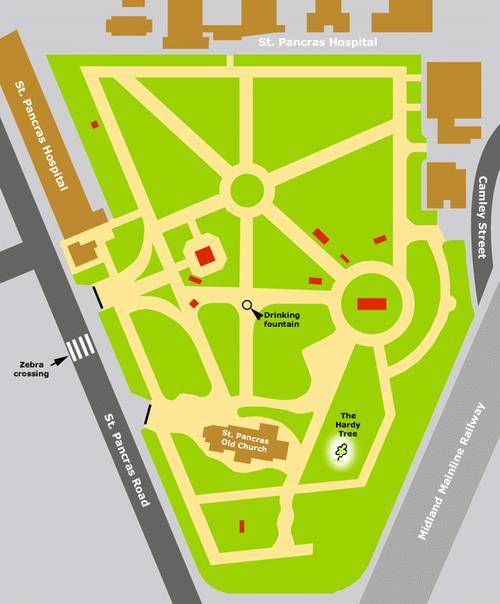
- The Ann Abbey Memorial
- This memorial, situated close to the Burdett-Coutts Memorial Sundial, is composed of Portland Limestone.
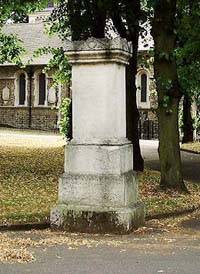
Weathering has made the inscription difficult to read, but has revealed horizontal lines of shelly material, indicating the orientation of the limestone’s bedding planes. (Compare with the John Walker Memorial).
See below, for a close up look at a horizontal shelly band.
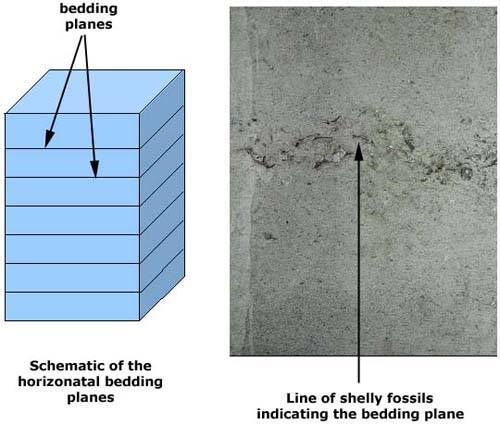
For more details on the cut of the Portland Stone and the orientation of the bedding planes in comparison to the John Walker Memorial
- Ann and William Birch's Gravestone
Situated just next to the Burdett-Coutts Memorial Sundial (visible in the background in the photograph on the right), this gravestone is composed of a grey granite.
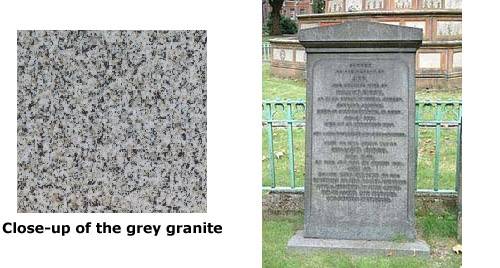
It is worth comparing it to the pink granite of William Henry Savage’s gravestone, which is also next to the Sundial.
SACRED
TO THE MEMORY OFANN
THE BELOVED WIFE OF
WILLIAM BIRCH
OF No 24 GREAT RUSSELL STREET
BEDFORD SQUARE
BORN AT SITTINGBOURNE, IN KENT,
MAY 5TH 1790
DIED 11TH OF DECEMBER 1847
SHE LIVED RESPECTED AND DIED LAMENTEDALSO OF THE ABOVE NAMED
WILLIAM BIRCH
WHO DIED
ON THE 18TH DAY OF AUGUST 1851
AGED 60
HAVING BEEN SURVEYOR OF THE
PAVEMENT OF THE UNITED PARISHES
AND A RESIDENT IN THIS PARISH
FOR 25 YEARS AND UPWARDS
AND GREATLY RESPECTED- The Burdett-Coutts Memorial Sundial
This memorial sundial, which is a Grade II listed structure, was unveiled in 1879 by Baroness Angela Georgina Burdett-Coutts (1814-1906), a great Victorian philanthropist who sought to rid London of its slums.
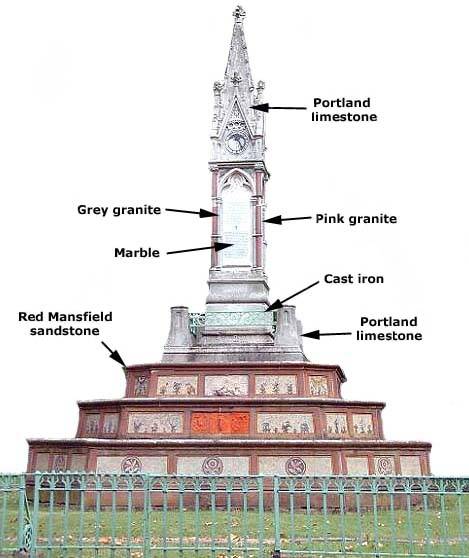
It lists the names of a number of eminent persons buried within St Pancras Gardens.
Geology
The memorial is constructed of Portland Limestone, marble, granite and Red Mansfield Sandstone (see below).
The whole structure is enclosed by cast iron railings with Portland Limestone statues at each corner, one of which is thought to have been modelled on the famous terrier, Greyfriars Bobby, which Baroness Burdett-Coutts saw and admired for its devotion to its dead owner.
- The Jane Grundy Memorial
This memorial, located next to the Soane Mausoleum, mainly comprises a striking pink granite, namely Peterhead granite.
The granite is polished and reveals clear feldspar laths and more anhedral quartz crystals. Zoned feldspars are visible and there are some xenoliths.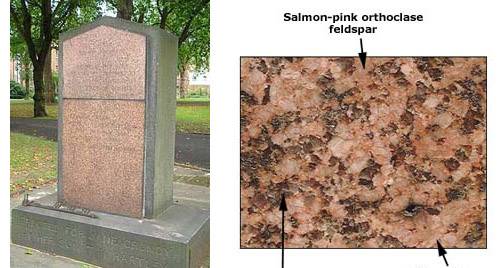
It is mounted on a dark grey igneous rock with an unpolished surface. This stone is so dirty, it is impossible to distinguish it as anything other than 'igneous' in composition.
- The Flaxman Family Vault
The graves of John Flaxman (1755-1826) and his wife Ann (nee Denman) are extremely weathered, making it impossible to read the inscription on their surfaces.
However, it is possible to partially make out the message inscribed on the surrounding wall:
“THE FLAXMAN ……… FAMILY VAULTS”
Flaxman was a student of the Royal Academy and in 1775 became a designer for Wedgwood. From 1887 he directed Wedgwood's studio in Rome. He became the Royal Academy's first Professor of Sculpture (1810-1826) and his work can be seen in Westminster Abbey and St. Paul's Cathedral.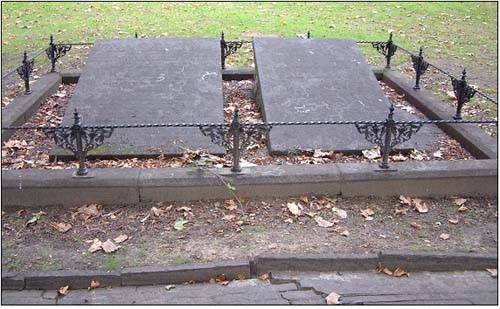
Though the surfaces of the gravestones are smooth and apparently featureless, the backs of the show some protruding shelly material, indicating that this is Portland Limestone.
The surrounding walls are topped by a painted cast iron fence.
- William Jones’ Gravestone
William Jones was a schoolmaster of Charles Dickens at Wellington House Classical and Commercial Academy on Hampstead Road.
Dickens joined the Academy, run by William Jones, in 1825. The school was the original inspiration for Salem House in David Copperfield, with Jones the basis for the sadistic Mr Creakle.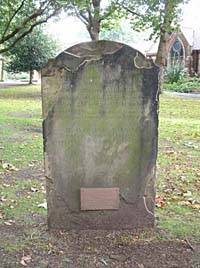
Dickens’ experiences prompted two other recollections of Wellington House: in his essay "Our School' he noted that Jones ("the Chief") had a penchant for ruling ciphering-books, and then "smiting the palms of offenders with the same diabolical instrument"; in a speech of 1857 he said it was Jones' business "to make as much out of us and put as little into us as possible“.
Geology
The gravestone is composed of a sandstone that has been cut parallel to its bedding planes. Weathering has exploited these planes, resulting in flaking of the surface.
This has produced large coherent flakes of sandstone that have detached from the surface, leaving it very uneven.(SAC)RED
(to) the Memory of
(Maria)* the beloved Daughter
of WILLIAM and MARY JONES
of the Hampstead Road;
who departed this Life
(o)n the 5th day of February 1827
Aged 2 Years and 2 Months
(Sweet) Child thy lingering sufferings are now o'erAlso SACRED to the Memory of
MR. WILLIAM JONES
for many years Master of
a respectable School in this Parish
who departed this life
on the 20th day of January 1836
Aged 59 YearsThe inflexible integrity of his Character
and the social and domestic Virtues
which adorned his private Life,
will long be cherished in the recollection (of)
all those who knew him.*Although illegible, this must be Maria Jones, daughter of William Jones and Mary (nee Cherry), born 2 December 1824, and christened at St. Pancras Old Church on 6 January 1825.
- Rhodes Family Grave
Located to the south of Old St. Pancras Church, this grave for the family of Cecil Rhodes (himself buried in Zimbabwe) is composed of both pink and grey granite, allowing easy comparison between the two.
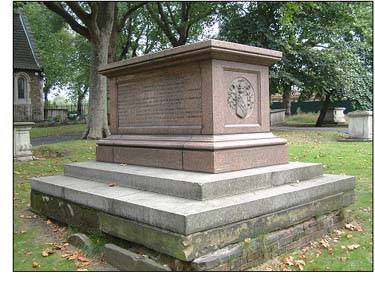
The pink granite (below) is very similar to that seen previously on the Jane Grundy Memorial, although it is lacking xenoliths, and has a polished surface.
The grey granite, on the other hand, is unpolished and has a rough texture, in contrast to the granite seen on Ann and William Birch’s gravestone.
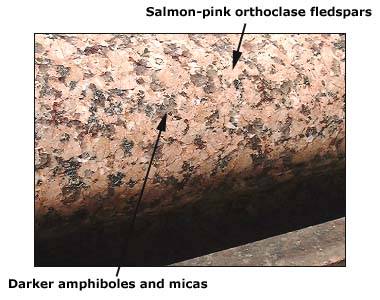
- The Soane Mausoleum
This mausoleum was designed by Sir John Soane RA (1753-1837), architect of the Bank of England, and was erected in 1816 following the death of his wife Elizabeth in 1815. It contains his wife and son as well as himself.
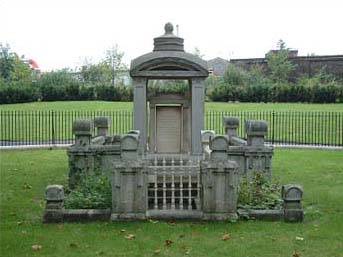
Geology
The central marble cube is enclosed by a marble canopy supported on four Ionic columns. Enclosing this central structure is a Portland Limestone balustrade with a flight of steps into the vault itself.It is possible to see creamy white rendering from when it was restored in both 1996 and 2000–2001.
For more information about Sir John Soane, visit Sir John Soane's Museum Lincoln's Inn Fields, London.
- The Tate Family Grave
- This gravestone is composed of Carrara Marble, a stone favoured by Michelangelo for his sculptures.
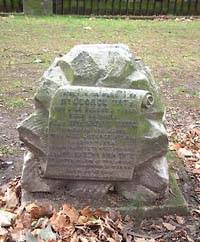
Marble gravestones decay mainly through dissolution by acidic rainfall (NB natural rainfall is slightly acidic anyway being a weak carbonic acid with a pH of 5.6).
Dissolution removes matrix and grains from the surface of the gravestone producing a 'sugary' surface. If you pass your hand over the gravestone surface it will have a slightly roughened feel.
(S)ACRED (T)O (T)HE MEMO(R)Y OF
MR. GEORGE TATE
WHO DIED AUGUST ( ) 18(33)*
AGED 48 YEARS
ALSO MRS SARAH TATE
WIDOW OF (T)HE ABOVE
WHO DIED (OC)TOBER 10TH 1851
AGED 61 YEARS
READER PREPARE TO MEET THY GOD
ALSO MRS MARTHA ANN TATE
DAUGHTER IN LAW OF THE ABOVE
WHO DIED SEPTEMBER 15TH 1853
AGED 46 YEARS,
BLESSED ARE THE ( ) WHO ( )*George Tate was born in East Retford, Nottinghamshire, in 1785, so he must have died in 1833 (although this is unreadable). His wife, Sarah (nee Walker, of West Retford) was born in 1789.
- The John Walker Memorial
- This memorial, which was preserved by Baroness Burdett-Coutts in 1877, is situated next to the Soane Mausoleum.
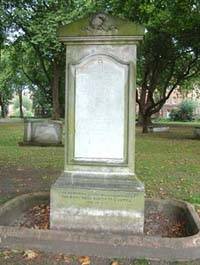
Geology
The memorial is made from Portland Limestone and it is possible to see vertical bands of shelly material, indicating the orientation of the bedding planes. (Compare with the Ann Abbey Memorial).
The stone has been considerably weathered, making the inscription difficult to read and causing the lead lettering to stand proud from the surface.
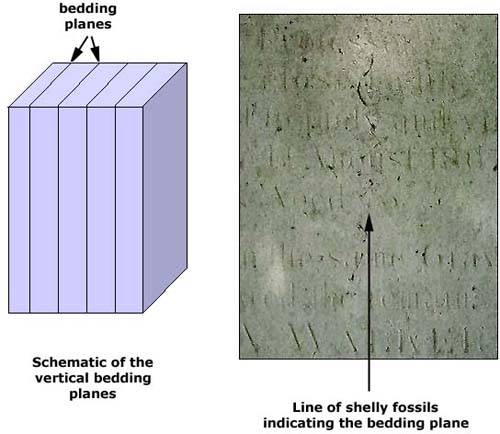
For more information on raised lead lettering and rates of weathering
 Close
Close


